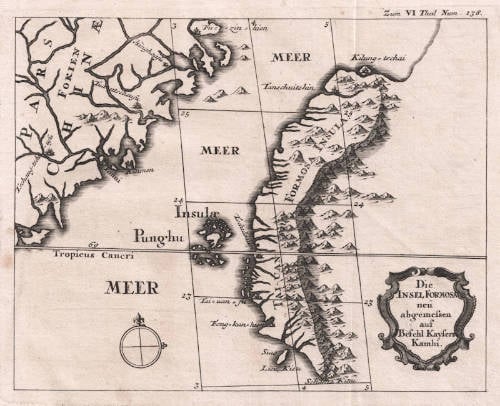Leen Helmink Antique Maps
The first English book on China, by Alvarez de Semedo
Stock number: 18690
Zoom ImageCartographer(s)
Álvaro de Semedo (biography)
Title
An Exact Mapp of China, being faithfully Copied from one brought from Peking by a Father Lately resident in that Citty. 1655
First Published
London, 1655
This Edition
1655 first edition
Technique
Condition
Fine
Price
$ 5,500.00
(Convert price to other currencies)
Description
The history of that great and renowned monarchy of China. Wherein all the particular provinces are accurately described: as also the dispositions, manners, learning, lawes, militia, government, and religion of the people.
Together with the traffick and commodities of that countrey.
Lately written in Italian by F. Alvarez Semedo, a Portugess, after he had resided twenty two yeares at the Court, and other Famous Cities of that Kingdom.
Now put into English by a person of quality, and illustrated with several mapps and figures to satisfie the curious, and advance the Trade of Great BRITTAIN.
To which is added the history of the late invasion and conquest of that flourishing kingdom by the Tartars.
With an exact account of the other affairs of CHINA till these present times.
London: Printed by E. Tyler for Iohn Crook, and are to be sold at his Shop at the Sign of the Ship in S. Pauls Church-yard, 1655.
2 parts in one volume, 2° folio (288 x 183mm). 2 engraved portrait frontispieces, 2 engraved maps of China (one folding, one full-page in the text), engraved costume plate, bookseller's advertisement leaf at end, contemporary calf.
A crisp copy in contemporary binding.
An Exact Mapp of China
The general layout of the folding map is derived from Samuel Purchas’ map from 1625, the first figure map of China and the first in the English language. Semedo’s map, first published in Rome, 1643, appears in "Relazione della grande Monarchia della China", and differs from Purchas’ in its different figures and the lack of squared and circled cities. While Webb is copying Semedo’s map directly except for the translated text, Nicholas Sanson in Paris, amongst others, used it as a source for his atlas map of China without the figures. The title of the map reads: "An Exact Mapp of China, being a faithfully Copied from one brought fro Peking by a Father Lately resident in that Citty".
(The Map House of London)
FIRST EDITION IN ENGLISH
Alvarez Semedo (or Semmedo) served as Portuguese Procurado General for China, and the first part of the present work, first published in Madrid in 1642 under the title Imperio de la China, includes much valuable material. Much of the information is derived from first-hand observation and remarkably free from the Western prejudice that was to become so prevalent in later works.
The second part is based on Martino Martini's De Bello Tartarico Historia (1654) - the story of the Manchu conquest of China, a work that was at the time was considered the best general description of China.
For a full overview of the content of the book, see this example of the University of California Library.
Literature
Cordier, Sinica 1:25; Lust 72; Wing S2490.
Álvaro de Semedo (1585/86-1658)
Álvaro de Semedo (Latinized form: Alvarus de Semedo; Chinese: 曾德昭, Zeng Dezhao, earlier 謝務祿 Xie Wulu) (1585 or 1586 - 18 July 1658), was a Portuguese Jesuit priest and missionary in China.
Álvaro Semedo was born in Nisa, Portugal in 1585 or 1586. He entered the Jesuit novitiate in 1602, and on 29 March 1608, he left for Goa and the Far East aboard Nossa Sra. do Vencimento. He arrived in Macau in 1610, and Nanjing in 1613. Along with another Jesuit, Alfonso Vagnoni, he was imprisoned during an anti-Christian campaign in Nanjing in 1616, and then sent back to Macau, where he stayed till 1621.
As the persecution campaign in the mainland China abated, Fr. Semedo changed his Chinese name from Xie Wulu to Zeng Dezhao and re-entered China, now working in Jiangsu and Jiangnan provinces. He spent most of his term in China in the central and southern provinces; perhaps his only trip north was the one he made to Xi'an in 1625, during which he was the first European to see the recently unearthed Nestorian Stele.
In 1636, Semedo went back to Europe as a procurator, sent by his Order to recruit people for the China mission and to ensure continued assistance from the church in Europe. During his sojourn in Europe, he wrote a long report on China, which was translated from Portuguese and published in Spanish, in 1642, under the title Imperio de la China.
After his return to China, Semedo served in Guangzhou (Canton) as the Vice-Provincial of the Jesuit China Mission. During several years after the fall of Beijing to the Manchus in 1644, he continued to work with the Ming loyalist regimes in the Southern China (notably, sending Michał Boym to the court of the Southern Ming Yongli Emperor), even as most Jesuits elsewhere in China were switching their loyalty to the recently established Qing Dynasty. Once the Qing took Canton, Semedo was detained, but was freed a few months later, reportedly due to the interference of Beijing-based Johann Adam Schall von Bell. He spent the rest of his life in Guangzhou, where he died.
(Wikipedia)
Related Categories
Related Items






